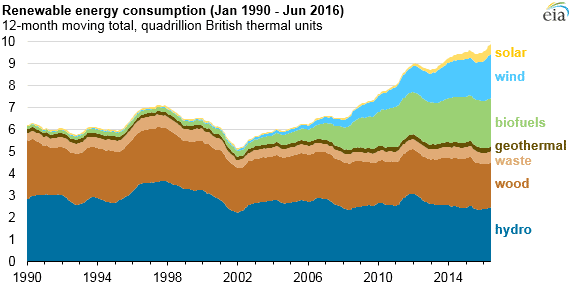Despite the relatively slow uptake of renewable energy in the United States, replacement of fossil fuels with renewables is starting to have tangible results on emissions, according to an analysis by the U.S. Department of Energy’s Energy Information Administration (EIA).
Today EIA reported that energy-related carbon dioxide (CO2) emissions fell to 2,530 million metric tons in the first six months of 2016, the lowest level of emissions for the first six months of the year since 1991.
Ironically, Climate Change is likely to have the largest role here. From January through June record temperature increases meant that the United States had the fewest number of “heating degree days” in the 66 years that EIA has kept monthly data for all 50 states. The result is that residential energy consumption fell 9% year-over-year, which led a 2% fall in overall energy consumption.

However, the consumption of renewable energy also increased 9% during the first six months of 2016 versus the prior year. Overall, renewable energy rose to nearly 17% of U.S. electricity production during the first half of 2016 (but a smaller portion of primary energy), due to rising wind and hydro output and to a lesser degree solar. However, both distributed and utility-scale solar PV still made up only 1.3% of total electricity production during these six months.
EIA notes that solar will likely add the most capacity of any energy resource this year. GTM Research is currently predicting that the United States will add 13.9 GW of capacity over the full year, and reports that over 10 GW of utility-scale solar is currently under construction.
Another factor behind falling CO2 emissions is the increasing switch from coal to gas. This was particularly noticeable this year, with an 18% fall in coal consumption and only 1% fall in gas consumption.
And while EIA observes that gas produces less CO2 than coal per unit of energy produced during combustion, what is not counted in this analysis is that natural gas is mostly methane (CH4), a greenhouse gas many times more potent than CO2.
A number of scientific reports have raised alarm over the large quantities of CH4 that appear to be leaking during the hydraulic fracturing (“fracking”) extraction process, which represents an increasing share of domestic gas production.
This content is protected by copyright and may not be reused. If you want to cooperate with us and would like to reuse some of our content, please contact: editors@pv-magazine.com.








By submitting this form you agree to pv magazine using your data for the purposes of publishing your comment.
Your personal data will only be disclosed or otherwise transmitted to third parties for the purposes of spam filtering or if this is necessary for technical maintenance of the website. Any other transfer to third parties will not take place unless this is justified on the basis of applicable data protection regulations or if pv magazine is legally obliged to do so.
You may revoke this consent at any time with effect for the future, in which case your personal data will be deleted immediately. Otherwise, your data will be deleted if pv magazine has processed your request or the purpose of data storage is fulfilled.
Further information on data privacy can be found in our Data Protection Policy.